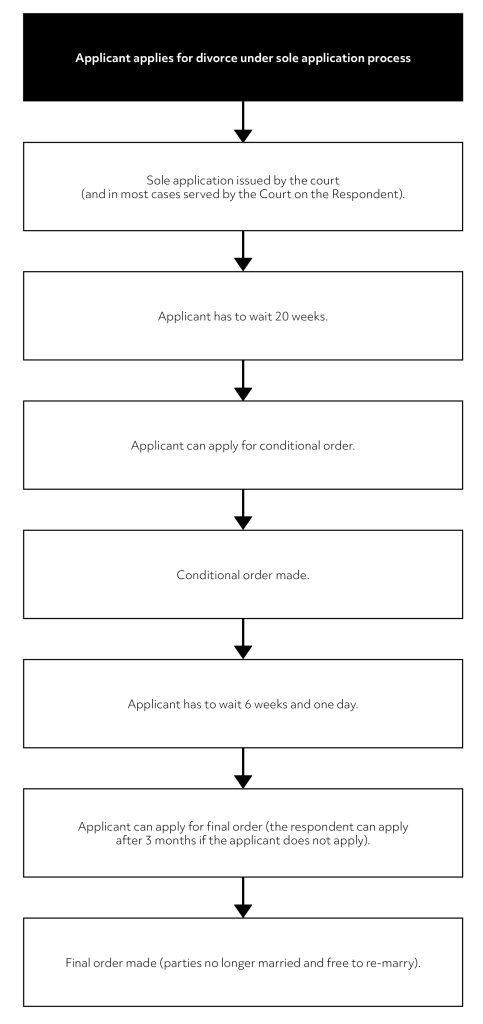The Divorce Process
11th May, 2022
Getting a divorce can be a daunting prospect for many people. As well as having to deal with the breakdown of your marriage, you are now faced with the stress of going through a divorce.
Whilst the divorce process can seem complex at a first glance, in reality it is not a stressful or complicated procedure for the majority of divorces.
To help you know what to expect from the outset of your divorce proceedings and relieve some of the stress you may be experiencing, this article breaks the divorce process into simple stages, providing a brief summary of each stage.

- Applicant applies for divorce under sole application process
The first stage in the divorce process is to issue a divorce application with the court. This document primarily outlines that your marriage has broken down irretrievably. In the UK, no fault divorce laws have recently came into force, removing the need for unnecessary finger-pointing and acrimony.
- Sole application issued by the court (and in most cases served by the Court on the Respondent).
If you are a sole applicant, the divorce application will be sent to your husband/wife, and they will have to acknowledge receipt of the application in order for the divorce to proceed. If your husband/wife refuses to acknowledge the divorce application, then we would recommend obtaining legal advice before proceeding.
- Applicant has to wait 20 weeks.
The law lays down a minimum allowable period of 20 weeks between the application and the conditional order, with this period offering adequate time to reflect, potentially turn back, or to agree important arrangements for the future. It is at the end of this stage that the court are satisfied that you are entitled to a divorce, and once the 20 weeks has passed, you can then apply to the court for a conditional order.
- Applicant can apply for conditional order.
A conditional order and decree nisi are documents that say that the court does not see any reason you cannot divorce. You can apply for these documents either online or by sending the application form via post.
- Conditional order made
If the judge agrees to the divorce, the court set a fixed date for the conditional order or decree nisi to be pronounced and a notification of this date is sent to both parties’ solicitors. This stage may take several weeks.
The decree nisi is pronounced by the judge in open court on the identified date. Whilst it is not necessary for either party to attend court, you may be required to if there is any particular issue that they wish to object to. You will still be married after the conditional order or decree nisi has been granted.
- Applicant has to wait 6 weeks and one day
Once you receive your conditional order or decree nisi, you have to wait a minimum of 6 weeks and one day before you can apply for your final order, also known as decree absolute.
- Applicant can apply for final order (the respondent can apply after 3 months if the applicant does not apply)
This stage involves applying for the conditional order or decree nisi to be made final, with a final order or decree absolute. If you applied for a divorce online, then you will be told how to apply for the final order online. Alternatively, you will be able to apply for a final order by filling in the relevant form and posting it to the relevant address.
- Final order made (parties no longer married and free to re-marry).
The Final Order formally ends your marriage. The application is dealt with immediately by a court clerk and it is at this moment that your divorce is finalised, and the marriage has officially ended. At this point you can marry or enter into another civil partnership.
Seeking Expert Support for Divorce
It is always in your best interest to seek legal advice when going through a divorce, especially if you are going through a high conflict divorce. Our experienced divorce lawyers understand the stress of facing a divorce and can make the process simple, hassle free and affordable.
Please note that this briefing is designed to be informative, not advisory and represents our understanding of English law and practice as at the date indicated. We would always recommend that you should seek specific guidance on any particular legal issue.
This page may contain links that direct you to third party websites. We have no control over and are not responsible for the content, use by you or availability of those third party websites, for any products or services you buy through those sites or for the treatment of any personal information you provide to the third party.
Topics:


